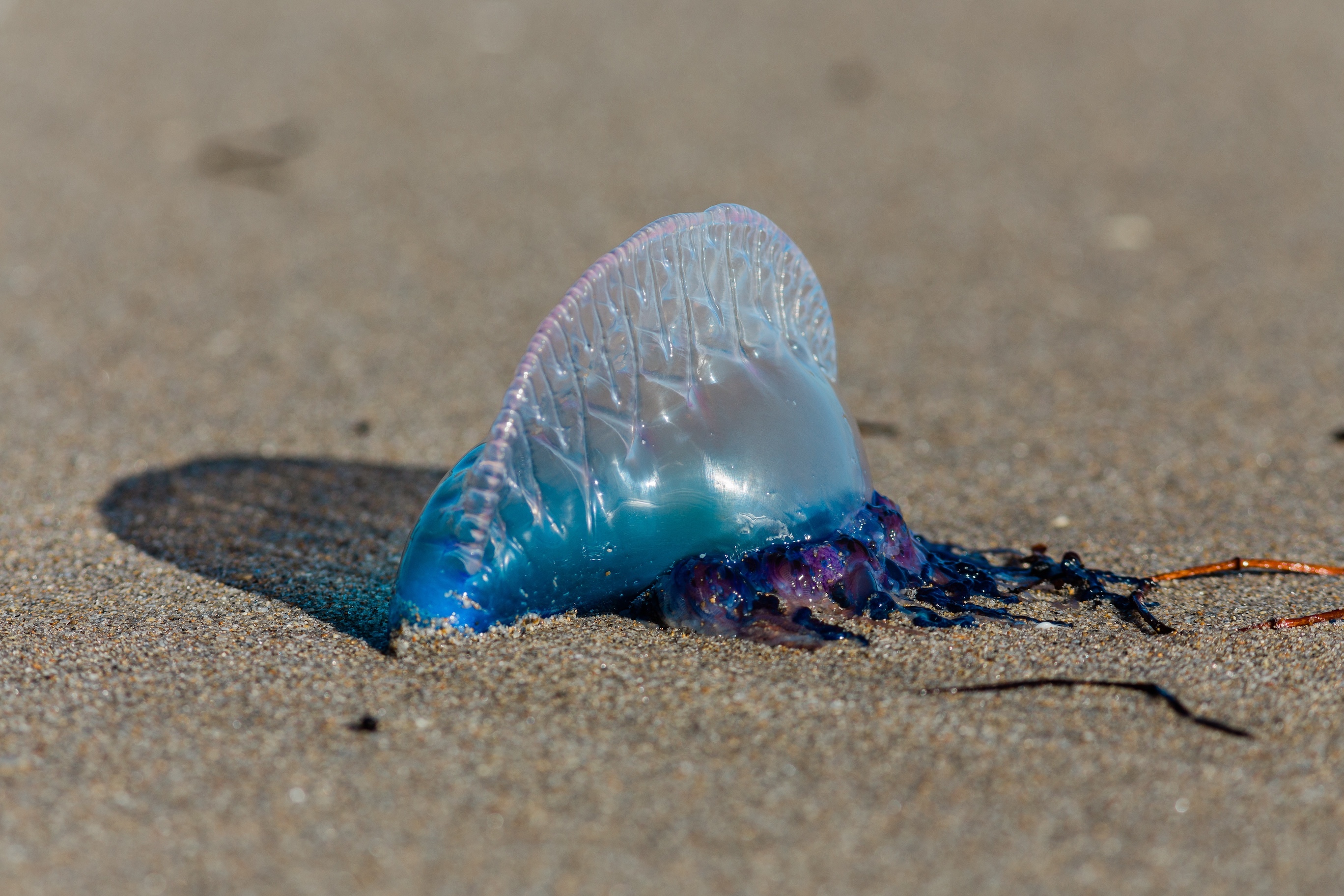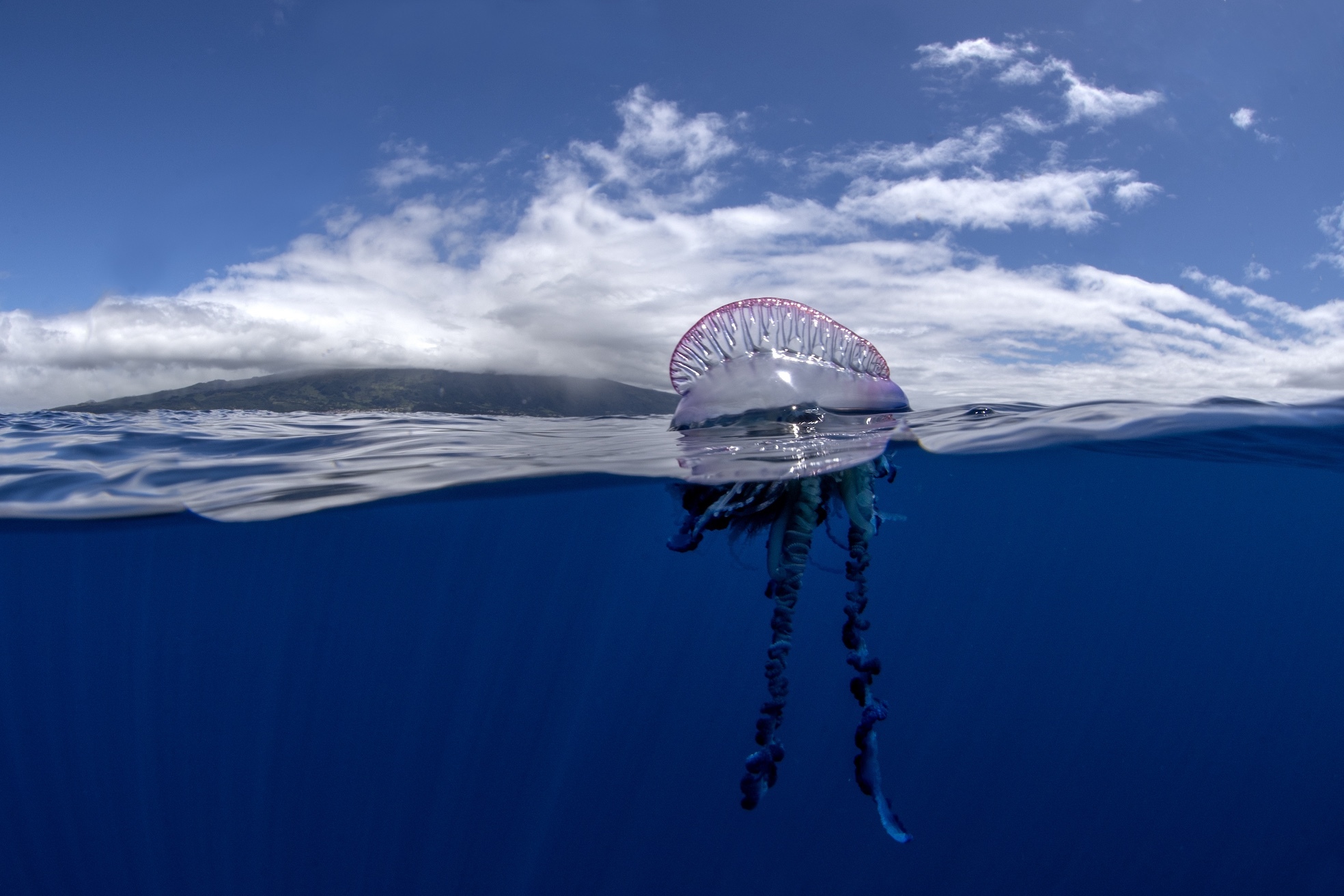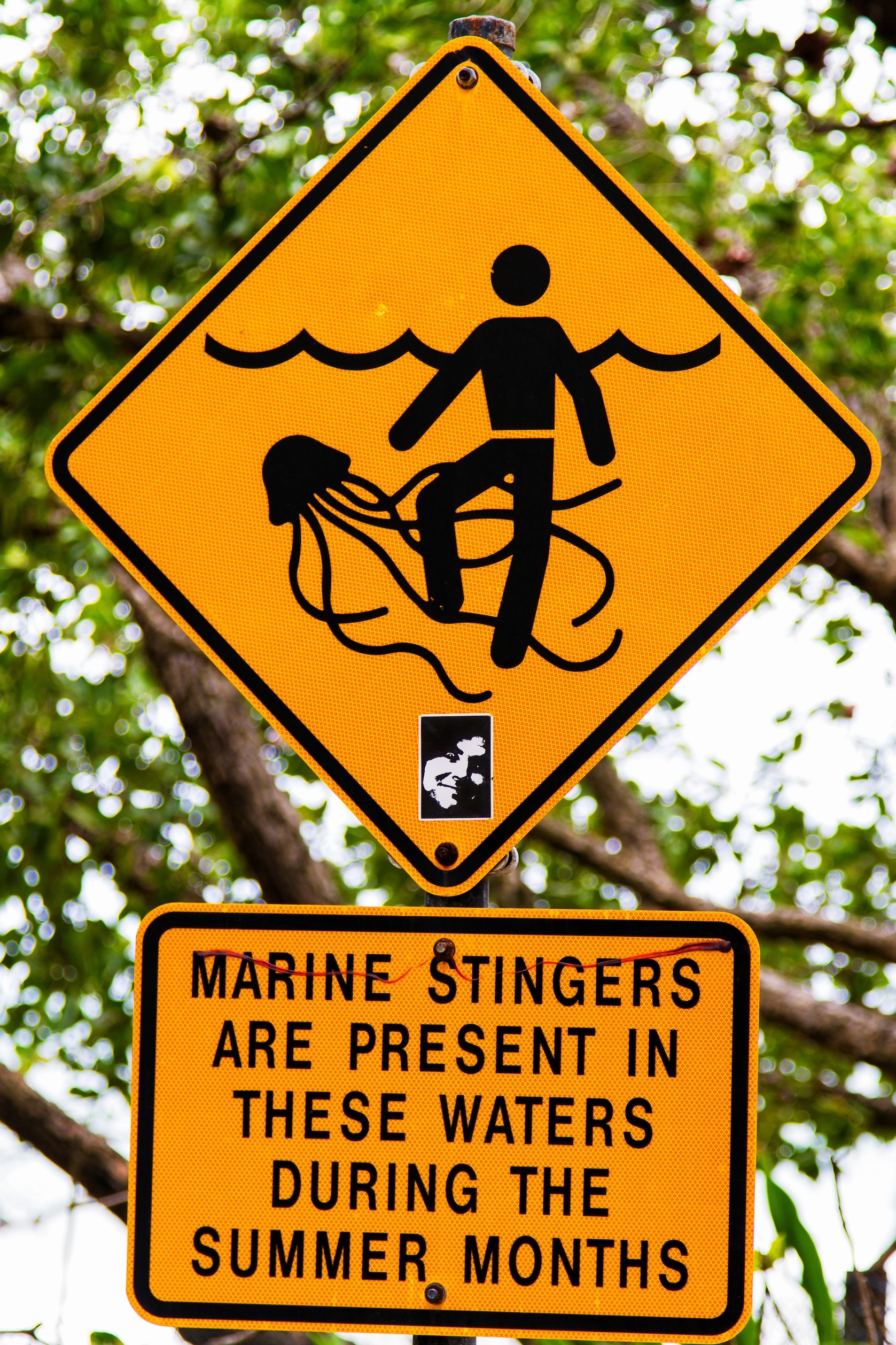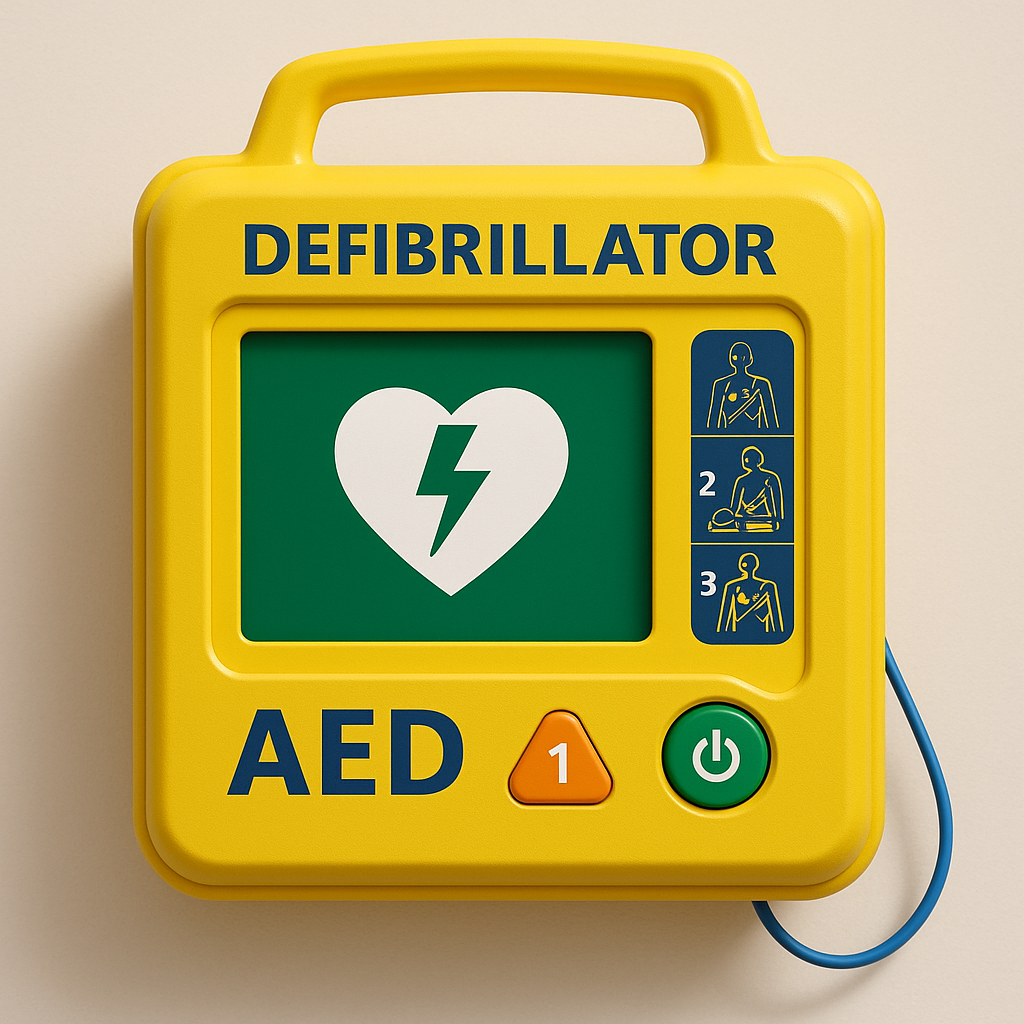Bluebottle Jellyfish Stings – Symptoms, Treatment & First Aid

Introduction: What Is a Bluebottle Jellyfish?
The bluebottle jellyfish (Physalia utriculus), also known as the Pacific Man o’ War, is a marine creature commonly found in Australian coastal waters, particularly during the summer season. These jellyfish-like organisms are closely related to the Portuguese Man o’ War and are often seen washed up on beaches due to ocean currents and weather conditions. They are most frequently encountered along the eastern and southern coasts of Australia, where they can pose a risk to swimmers and beachgoers.
Why Do Bluebottle Jellyfish Sting?
Unlike true jellyfish, bluebottle jellyfish are colonial organisms composed of multiple specialised polyps that work together. The most recognisable part of the bluebottle is its vibrant blue gas-filled float, which sits on the water’s surface, allowing the wind and currents to carry it across the ocean. Beneath the float, long bluebottle jellyfish tentacles trail through the water, containing venom-filled nematocysts. When these tentacles come into contact with human skin, they release venom, resulting in a blue bottle jellyfish sting that can cause intense pain, red welts, and discomfort.
Common Misconceptions About Bluebottle Stings
There are several myths surrounding bluebottle jellyfish stings that often lead to ineffective or even harmful first aid responses:
- Myth: Peeing on a sting helps relieve the pain.
- Fact: Urine does not neutralise bluebottle jellyfish venom and can even make the sting worse. Instead, rinsing with hot water is recommended.
- Myth: Vinegar is an effective treatment.
- Fact: Unlike some jellyfish species, bluebottle stings do not respond well to vinegar and may worsen the pain.
- Myth: Bluebottles can still sting when washed up on the beach.
- Fact: This is true! Even dead bluebottle jellyfish on the shore can deliver a painful sting if touched.
Where and When Are Bluebottles Most Common?
Bluebottles are often found on Australian beaches after strong onshore winds push them towards the coast. They are particularly common during the warmer months, when their numbers increase due to bluebottle jellyfish migration patterns. Beach safety authorities frequently issue bluebottle jellyfish beach warnings to inform the public about bluebottle jellyfish sting risk and prevent unnecessary injuries.
Understanding the bluebottle jellyfish and its behaviour can help swimmers and beachgoers take precautions to avoid painful bluebottle stings. Paying attention to bluebottle jellyfish beach alerts, recognising seasonal trends, and knowing how to avoid bluebottle jellyfish can significantly reduce the chances of an unwanted encounter.
Symptoms of a Bluebottle Jellyfish Sting
A bluebottle jellyfish sting can cause a range of symptoms, varying from mild discomfort to severe reactions requiring medical attention. The severity of the sting depends on the individual’s sensitivity, the amount of venom injected, and the location of the sting.
Immediate Symptoms
- Sharp pain and burning sensation – Often described as an intense, searing pain that peaks within minutes.
- Red welts and swelling – The sting site typically develops raised, inflamed streaks following the tentacle contact pattern.
- Itching and numbness – Some individuals may experience tingling, itching, or temporary numbness at the sting site.
Severe Reactions
While most bluebottle sting symptoms are mild to moderate, some people may experience severe reactions, including:
- Breathing difficulties – A rare but serious symptom that may indicate an allergic reaction or anaphylaxis.
- Nausea and dizziness – Some individuals may feel lightheaded or experience nausea following a sting.
- Muscle cramps and weakness – Severe cases can lead to painful muscle spasms and general weakness.
- Increased heart rate – Some individuals may notice palpitations due to the venom’s effects on the nervous system.
How Long Do Symptoms Last?
The duration of bluebottle sting pain depends on the severity of the sting:
- Mild cases – Pain usually subsides within 30 minutes to an hour, though redness and irritation may last for a few hours.
- Moderate cases – Swelling, itching, and discomfort can persist for several hours to a full day.
- Severe cases – Rarely, symptoms such as muscle pain, nausea, and lingering skin irritation may persist for multiple days.
Why Do Some People React More Strongly?
Reactions to bluebottle jellyfish stings vary due to several factors:
- Skin sensitivity – Individuals with sensitive skin or allergies may experience a heightened bluebottle sting reaction.
- Venom exposure – The length of time the tentacles remain in contact with the skin affects symptom severity.
- Immune response – Some people may develop a stronger inflammatory reaction due to their body’s histamine response.
- Pre-existing conditions – Individuals with asthma, heart conditions, or a history of severe allergies may be at higher risk of complications.
Comparing Bluebottle Stings to Other Marine Stings
Sting Type | Pain Level | Common Symptoms | Severity |
Bluebottle Jellyfish | Moderate to severe | Sharp pain, red welts, swelling | Usually mild, rarely life-threatening |
Box Jellyfish | Extreme | Severe burning, cardiac issues | Highly dangerous, can be fatal |
Irukandji Jellyfish | Severe | Nausea, vomiting, cardiac issues | Potentially deadly |
Stonefish | Excruciating | Swelling, tissue damage, heart issues | Extremely dangerous |
Sea Urchin | Moderate | Puncture wounds, swelling | Usually mild to moderate |
Recognising bluebottle jellyfish sting symptoms and knowing when to seek medical help is essential for effective blue bottle sting pain management and recovery.
First Aid for a Bluebottle Jellyfish Sting
A bluebottle jellyfish sting can be painful, but proper first aid for bluebottle sting can significantly reduce discomfort and prevent complications. Knowing how to treat bluebottle sting correctly is crucial for a quick recovery.
What to do Immediately After a Sting
1. Leave the water – If stung while swimming, get out of the water immediately to avoid further exposure.
2. Do not rub the sting site – Rubbing the area can cause the venomous cells to release more toxins.
3. Remove tentacles carefully – Use tweezers or the edge of a credit card to gently lift any remaining tentacles off the skin.
4. Rinse with seawater – Flush the area with saltwater to remove residual stinging cells; avoid freshwater as it can worsen the sting.
Should You Use Hot or Cold Water?
· Hot water treatment is recommended – Immerse the affected area in hot water (no hotter than can be tolerated) for 20–30 minutes. This helps neutralise the venom and reduce pain.
· Avoid cold water and ice packs – Cold can worsen symptoms and is less effective at relieving bluebottle sting pain.
Why Vinegar Is NOT Recommended
Unlike some other jellyfish stings, vinegar is not effective for bluebottle jellyfish first aid. Vinegar can cause the nematocysts (stinging cells) to discharge more venom, worsening the sting.
Mistakes to Avoid
· Do not rub the sting site – This can spread venom and worsen irritation.
· Do not apply vinegar – As mentioned earlier, vinegar is ineffective and may make symptoms worse.
· Do not apply alcohol or urine – These are ineffective and may increase pain.
· Do not use freshwater to rinse – It can trigger the release of more venom.
When to Seek Medical Attention
While most bluebottle jellyfish sting first aid can be managed at home, seek medical help if:
· The person experiences breathing difficulties, dizziness, or nausea.
· There is severe pain that does not subside with hot water treatment.
· The sting covers a large area of the body or affects the face, eyes, or genitals.
· Signs of an allergic reaction appear, such as swelling, hives, or difficulty breathing.
By following the correct bluebottle sting first aid steps, pain and complications can be minimised, allowing for a smoother recovery. Staying informed on bluebottle jellyfish beach warnings and how to treat bluebottle stings can help prevent unnecessary discomfort during beach outings.
Bluebottle Jellyfish Sting Treatment & Remedies
Proper bluebottle sting treatment can alleviate pain, reduce inflammation, and promote faster healing. Understanding both medical and natural remedies can help ensure a smooth recovery.
Over-the-Counter Pain Relief: What Works Best?
· Ibuprofen or aspirin – Helps reduce pain and inflammation.
· Antihistamines – Can relieve itching and swelling associated with the sting.
· Topical cortisone creams – Useful for reducing skin irritation and inflammation.
· Paracetamol – Provides pain relief but does not reduce inflammation.
Natural Remedies
Some bluebottle sting natural remedies may help soothe irritation and promote healing:
· Aloe vera – Known for its cooling and anti-inflammatory properties.
· Baking soda paste – Can help neutralise venom and soothe itching.
· Essential oils (e.g., lavender, tea tree oil) – May provide mild pain relief and antibacterial effects.
· Coconut oil or honey – Can help moisturise and promote skin healing.
Can You Prevent Scarring from a Bluebottle Sting?
Most bluebottle sting marks fade over time, but to minimise scarring:
· Avoid scratching – This can worsen irritation and delay healing.
· Use moisturising creams – Helps prevent skin dryness and supports regeneration.
· Apply sunscreen – Protects healing skin from sun damage, reducing long-term discoloration.
· Massage therapy – Gentle massage may help break down scar tissue.
How Long Does It Take to Fully Heal?
The bluebottle sting recovery timeline depends on severity:
· Mild cases – Symptoms subside within hours, with redness fading in a few days.
· Moderate cases – Swelling and itching may last up to a week.
· Severe cases – Some people may experience lingering skin sensitivity or discoloration for several weeks.
Staying hydrated and maintaining proper post-treatment care can support the body's natural healing process. For severe reactions or prolonged symptoms, consult a medical professional for further bluebottle jellyfish treatment options.

How to Avoid Getting Stung by a Bluebottle Jellyfish
Bluebottle jellyfish are common in Australian coastal waters, particularly during Bluebottle season. Following beach safety tips and knowing how to identify them can help minimise the risk of painful stings.
Best Beach Safety Tips During Bluebottle Season
· Check beach warnings – Look for posted signs and alerts about Bluebottle jellyfish presence before entering the water.
· Avoid swimming on windy days – Strong onshore winds can bring Bluebottle jellyfish close to shore.
· Observe lifeguard instructions – Always swim at patrolled beaches where lifeguards provide updated safety information.
· Exit the water immediately if stung – If you get stung, avoid rubbing the area and seek first aid for Bluebottle stings.
How to Identify Bluebottle Jellyfish in the Water
· Distinctive blue float – Bluebottles have a vibrant blue, gas-filled float that sits on the water’s surface.
· Long trailing tentacles – Their tentacles can extend several metres and are often difficult to see in the water.
· Clusters in warm conditions – Bluebottles tend to appear in large numbers, especially during warm summer months.
What to Do If You See Beached Bluebottles
· Do not touch them – Even dead Bluebottle jellyfish on the sand can still sting.
· Warn others nearby – Let fellow beachgoers know to keep a safe distance.
· Avoid walking barefoot – Tentacles may remain on the sand, posing a risk of accidental stings.
Protective Gear: Are Stinger Suits Necessary?
· Stinger suits provide protection – While more commonly used for box jellyfish, they can help reduce contact with Bluebottle tentacles.
· Rash vests and wetsuits – These offer some protection against stings, especially for swimmers and surfers.
· Water shoes – Useful for beachgoers walking along the shoreline to avoid stray tentacles.
By following these Bluebottle jellyfish beach safety precautions, you can reduce the risk of getting stung while enjoying Australia’s coastal waters.

Conclusion: Should You Be Worried About a Bluebottle Sting?
A Bluebottle jellyfish sting can be painful, but in most cases, it is not life-threatening. Understanding the risks and proper treatment can ensure a smooth and pain-free recovery.
Final Verdict: Are Bluebottle Stings Dangerous?
· Generally, no – While Bluebottle stings cause sharp pain and discomfort, they are rarely serious.
· Severe reactions are uncommon – Most people recover quickly, but individuals with allergies or sensitivities may experience stronger symptoms.
· Medical attention may be required – If symptoms persist or worsen, seek professional care.
When to Worry About Complications
· Breathing difficulties or dizziness – Could indicate a severe allergic reaction requiring emergency assistance.
· Persistent pain beyond 24 hours – If pain does not subside with treatment, medical evaluation is recommended.
· Signs of infection – Increased redness, swelling, or pus at the sting site may require antibiotics.
Best Prevention & Treatment Tips for a Pain-Free Recovery
· Check beach warnings – Avoid swimming when Bluebottles are reported in the area.
· Wear protective clothing – Rash vests or stinger suits can reduce the risk of tentacle contact.
· Use hot water treatment – Immersing the sting site in hot water helps neutralise venom and ease pain.
· Avoid common mistakes – Do not rub the sting, apply vinegar, or use freshwater to rinse.
By following these Bluebottle sting prevention and treatment tips, you can enjoy the beach safely while minimising the risk of discomfort. While Bluebottle jellyfish stings can be unpleasant, proper care ensures a quick recovery with minimal complications.

Nationally-Recognised
& Accredited Courses
- Popular Courses11 Courses
- First Aid Courses65 Courses
- Agriculture & Chemicals Courses1 Courses
- Anaphylaxis Training Courses5 Courses
- Chainsaw Training Courses6 Courses
- Construction, Industry and Resources Courses52 Courses
- White Card Courses7 Courses
- LVR Training Courses3 Courses
- Fire & Emergency Courses19 Courses
- Food Safety Courses4 Courses
- Health & Safety Courses11 Courses
- Health Care Setting Courses8 Courses
- Home & Community Care Courses9 Courses
- Online Courses24 Courses
- Qualifications3 Courses
- Specimen Collection Courses1 Courses
- Sport, Fitness and Recreation Courses17 Courses
- Wellbeing & Child Protection Courses7 Courses
- Pool Safety Inspector PD6 Courses
Share This Article:
Articles, Updates & Announcements
from Allen’s Training
Read More

Be the Key to Safer Pools: Professional Development for Licensed Pool Safety Inspectors
Continue Reading
How to Use an AED
Continue Reading
🌍 World First Aid Day – Would You Know What to Do in an Emergency?
You’re out shopping when someone collapses nearby. People freeze. A few gather. Time ticks by. Would you know what to do? On Saturday 13th September, we recognise World First Aid Day a global reminder that knowing first aid isn’t just a nice skill to have. It’s something that could save a life a friend’s, a stranger’s, or even your own. Emergencies don’t wait for professionals. In those first cruc...
Continue Reading